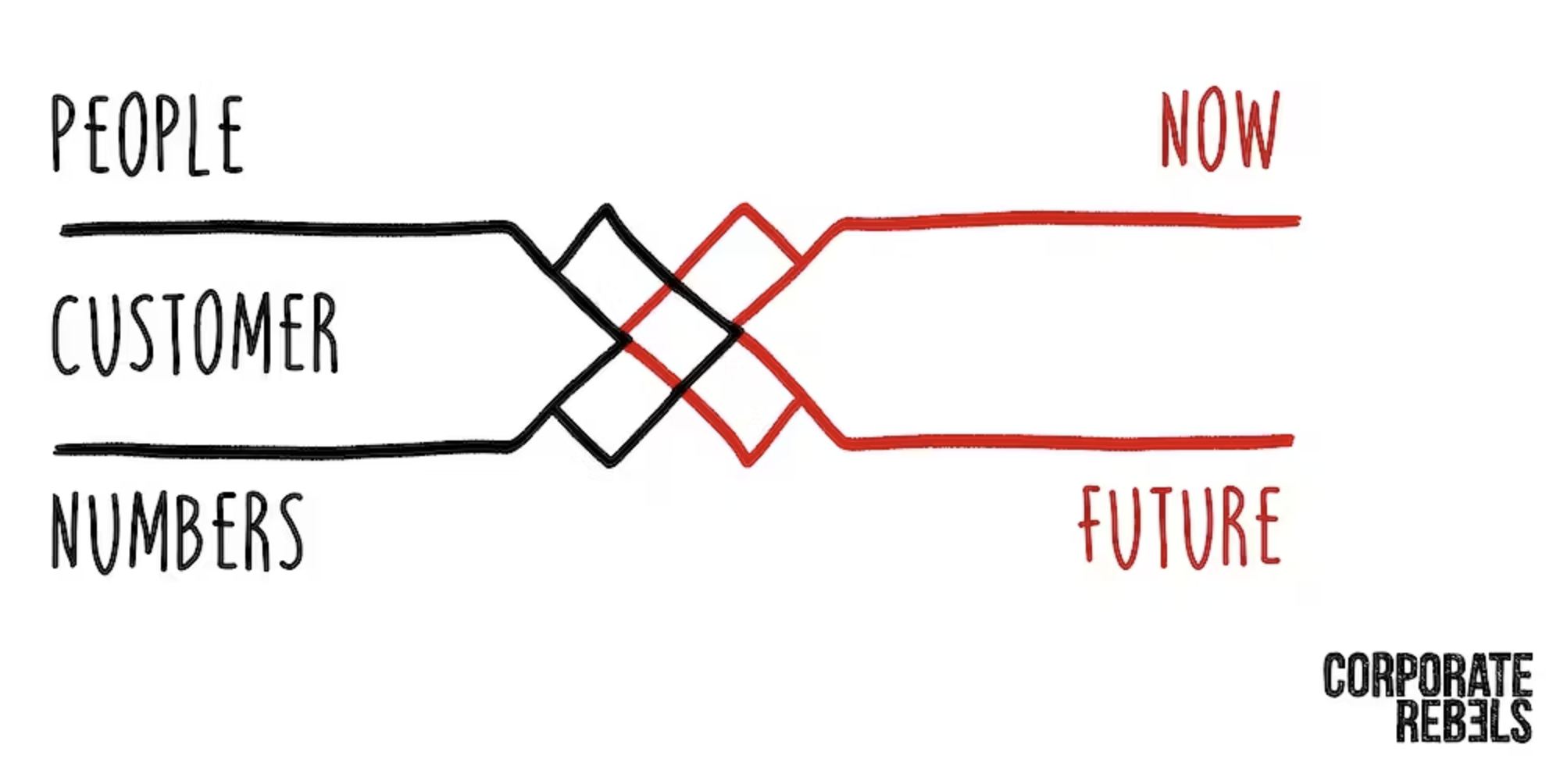By Perttu Salovaara and originally published at corporate-rebels.com
Instead of self-management, Columbia Road, the digital sales agency based in Finland, replaces traditional hierarchy with community-led practices. What are these?
Columbia Road, the Nordic digital sales agency with 150+ employees, describes itself as a flat-hierarchy organisation. Instead of self-management – which creates an image of endless individual freedom – they talk about community-led organizing.
“For us, ‘self-managed’ gave a wrong connotation. Not everybody does their own thing or works in silos. We usually work in cross-competence teams, and in client environments where collaboration is key to success. The Finnish word yhteisöohjautuvuus, which we translate as community-led, resonated most”, says Senior Consultant, and HR Lead, Sally Pett.
Columbia Road’s community-led practices are a social innovation, similar to practices other alternative organizations have created.
Version 2.0 of alternative hierarchy emphasizes community
Over the past 10 years, the first wave of self-management focused on employee autonomy. But underlining ‘self’ gives little incentive to work together, something many IT companies have noticed. Put differently, emphasizing individuals, however talented, works against collaboration.
From its beginning, Columbia Road has developed structures that support employee autonomy and feel that their approach has been more about community-led structures instead of self-management ones.
Version 2.0 of the alternative to hierarchy seeks innovative solutions for organizing from the community and peer-based collaboration.
“Columbia Road is not alone in its pursuit of a flat hierarchy. Yet its emphasis on community-led organizing and practices is something not many others have tapped into – yet.”
The importance of structures in flat organizations
Whereas traditional hierarchical companies have tons of structures to support vertical decision-making, flat organizations require structures too. “Structures act as enablers, making sure that people are supported and have visibility, as well as creating alignment within the organisation”, says Sirkka-Liisa Rotinen, Columbia Road CEO.
Today’s self-managing companies typically replace traditional management functions – decision-making, feedback, target setting, conflict resolution, and work allocation – with common decentralized practices.
When leadership doesn’t equal line management, it’s essential to ensure that leadership is taken on by the team and through company-wide shared practices.
A key to understanding how flat organizations really function is to consider these tools as ‘bundles of co-occurring elements’. A bundle of co-occurring elements conveys the idea that these tools should, in a systems fashion, not contradict each other, but need to be aligned.
For instance, decision-making power and transparency of information work well together, but produce suboptimal results if exercised separately: without the right information, a team ends up making bad decisions. This is why Columbia Road emphasizes that trust and transparency need to be shown in everyday interactions, not only preached.
Peer-based practices empower employees
Columbia Road’s ‘community-led practices’ are peer-based, commonly designed ways of co-working, that aim to replace the work typically carried out by line managers or supervisors in traditional hierarchical structures.
In a traditional organization line managers take care of work decision-making, distribution, setting targets and follow-up. At Columbia Road, these tasks are distributed and start with the employees themselves, with different functions such as Sales & Staffing and HR supporting them.
There are also Task Forces focusing on different topics or themes, such as diversity, equity and inclusion, internal communication and HR-related tasks such as recruiting.
In addition, more extempore project teams working on a specific topic for a fixed period of time may be created based on needs arising from the organisation.
1. Decision-making by advice process
The most common and best-known collaborative practice concerns decision-making, which Columbia Road calls the 3×2 advice process.

The process has two stages. If a person or a group needs to make any decision – big or small – they should first talk with the people who have expertise in the subject and will be affected by the decision. They should then consider its impact on the client, as well as the numbers, which refer to the financial impact of the decision.
In the second stage, the decision-makers should also consider the short and long-term effects of the decision.
2. Onboarding for a stronger team culture
Another practice focuses on recruiting and onboarding. When a candidate has signed their employment contract, they can join company events before their employment starts. This makes first day in the office not quite as strange. You already know some people and have a feel for the community around you.
Secondly, someone who has been part of the recruitment process will mentor the employee for the first six months. After this period, the person can hold what is called a Checkpoint with anyone in the organisation. A Checkpoint could be compared to a career-development discussion in traditional hierarchies. However, the objective of the discussion is the question: what are your goals for yourself? It is not so much about how we as a company get the most out of you, but how you will get the most out of working at the company.
3. Task forces and swarming to embrace flexibility
At Columbia Road, both long-term Task Forces and short-term project teams work on organizational-level themes and topics.
Sally Pett describes: “Task Forces usually arise from an organization need, while project teams are created to focus on particular topics or themes. Once the need for a project team has passed, it is disbanded.”
Individuals can apply to join Task Forces quite freely with some role or competence-related requirements, such as with HR-related Task Forces. These HR Task forces take care of salary decisions, recruitment and supporting new employees onboarding within a specific competence.
Typically line managers take on these duties, but at Columbia Road this is a distributed responsibility for a defined group of people. Therefore, Task Forces allow for the replacement of some tasks traditionally held by line managers or supervisors in more hierarchical organizations.
Based on our research, a common principle in self-managing organizations is to allow for self-selection of work and to form flexible cells/circles on topics people find relevant. Columbia Road addresses this through Task Forces which have a life cycle of birth, life and death. We call this ‘swarming’. People come together in a large group they can join freely and later step out of.
Columbia Road’s ‘community-led practices’ are peer-based, commonly designed ways of co-working, that aim to replace the work typically carried out by line managers or supervisors in traditional hierarchical structures.
A fresh approach to organizing
Columbia Road is not alone in its pursuit of a flat hierarchy. Yet its emphasis on community-led organizing and practices is something not many others have tapped into – yet.
The community-led organizing is not new. More egalitarian forms have always existed. (Check out the book “The Dawn of Everything” by archaeologists and anthropologists Graeber and Wengrow for more on that.)
But the thing is, creating, designing, and introducing community-led practices in modern organizations is new. It’s a social innovation, enabling working together in an egalitarian fashion.
That is some fashion statement, indeed!
Republished with permission.
Featured Image added by Enlivening Edge Magazine. Image by Gerd Altmann from Pixabay




